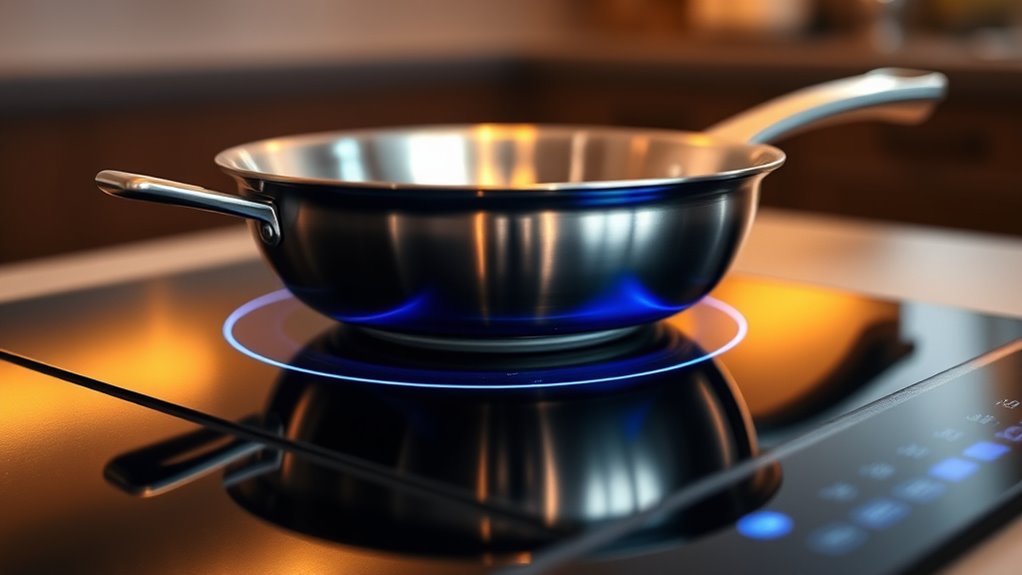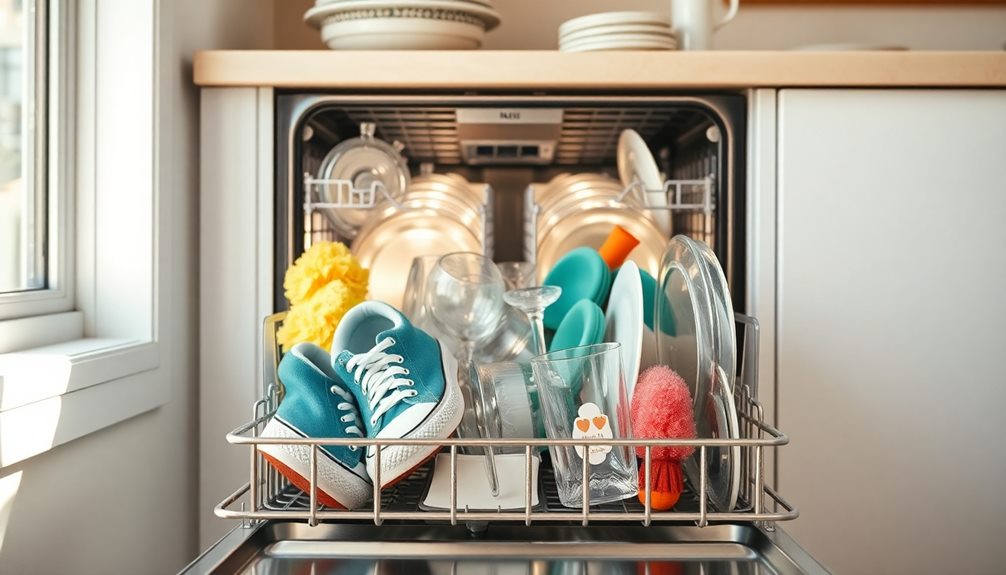Induction cooktops need special pans because they heat cookware directly through magnetic fields, which only work with ferromagnetic materials like cast iron or some stainless steel. If your pans aren’t magnetic, they won’t respond to the magnetic energy, leading to little or no heat. Using the right cookware guarantees efficient cooking, faster heat-up, and safe operation. Keep exploring to discover how to choose the best pans for your induction stove and get the most out of it.
Key Takeaways
- Induction cooktops heat cookware directly through magnetic fields, requiring ferromagnetic material in pans for effective heating.
- Non-compatible pans like aluminum or glass do not respond to magnetic fields, preventing proper heat generation.
- Magnetic cookware ensures efficient energy transfer, faster cooking, and even heat distribution on induction surfaces.
- Using the wrong pans can cause uneven cooking, hot spots, and potential damage to the cooktop.
- A simple magnet test helps determine if cookware is suitable for induction cooking, ensuring safety and optimal performance.
How Induction Cooking Works
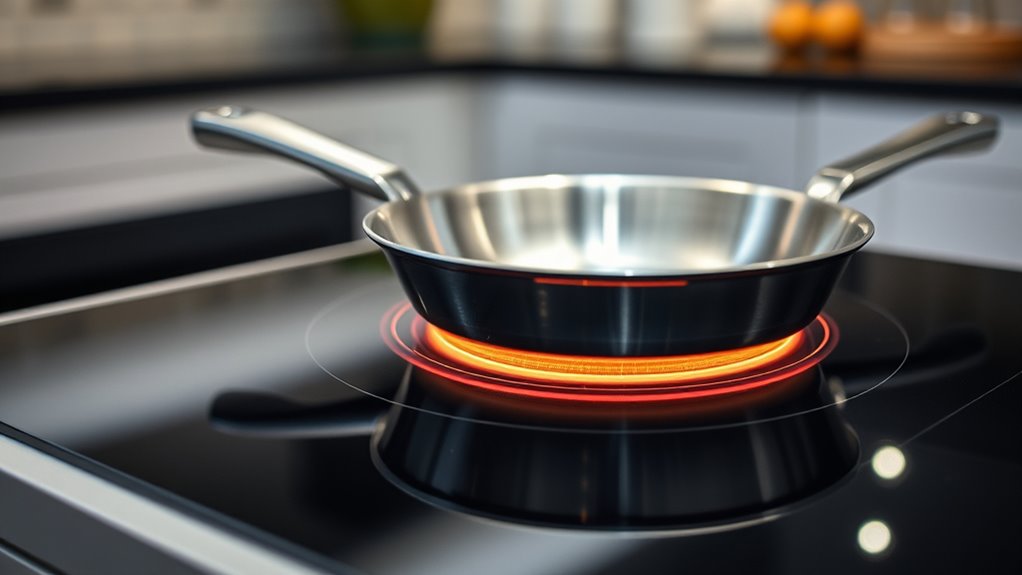
Induction cooking works by using electromagnetic fields to directly heat cookware, rather than the cooktop itself. When you turn on the stove, an electric current passes through a coil beneath the surface, creating a rapidly changing magnetic field. This magnetic field induces electric currents, called eddy currents, within the ferromagnetic material of your cookware. These currents generate heat directly in the pan, not on the cooktop. Because of this process, heat is produced only where the pan makes contact with the surface, leading to faster, more efficient cooking. The cooktop itself stays relatively cool, reducing heat loss and making it safer. This method allows for precise temperature control and quick adjustments, making induction cooking highly efficient and responsive for your kitchen needs. Additionally, ferromagnetic cookware is essential for effective heat transfer in induction cooking. Moreover, the energy transfer process is markedly more efficient than traditional methods, contributing to energy savings and environmental benefits.
The Role of Magnetic Fields in Heating
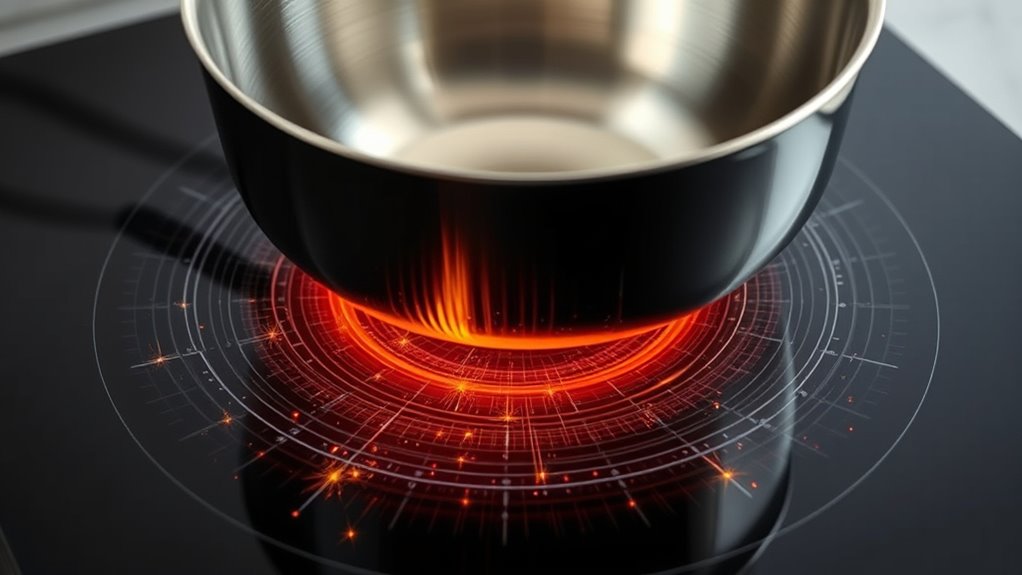
When you turn on an induction cooktop, a magnetic field is generated beneath the surface. This field interacts directly with ferromagnetic pans, causing their atoms to vibrate and produce heat. Understanding how this magnetic induction process works reveals how efficient and precise induction heating really is.
Magnetic Induction Process
The magnetic induction process relies on magnetic fields generated by the cooktop to heat compatible cookware directly. When you turn on an induction cooktop, an electric current flows through a coil beneath the surface, creating a magnetic field. This field induces electric currents—called eddy currents—in the cookware if it contains ferromagnetic material. These currents generate heat directly within the pan, not the cooktop surface. To guarantee efficient heating, keep these points in mind:
- Only ferromagnetic pans respond effectively.
- The cookware must be in direct contact with the cooktop surface.
- The magnetic field’s strength determines heating speed.
- Non-compatible materials won’t heat, regardless of power setting.
- Using the correct cookware material enhances induction efficiency and overall performance.
Additionally, proper cookware placement can significantly impact energy transfer and cooking results. Understanding this process helps you choose the right pans and optimize your cooking experience, especially since magnetic field strength plays a crucial role in heating performance.
Ferromagnetic Material Interaction
Magnetic fields generated by the cooktop interact directly with ferromagnetic materials in cookware, causing them to heat up efficiently. When you place a ferromagnetic pan on an induction cooktop, the magnetic field penetrates the metal, creating localized magnetic flux. This flux induces electric currents, known as eddy currents, within the ferromagnetic material. These currents generate heat directly within the pan’s body, not in the cooktop itself. Because ferromagnetic metals like cast iron and certain stainless steels have high magnetic permeability, they respond strongly to these magnetic fields. This interaction guarantees rapid, focused heating. Your cookware’s ferromagnetic properties are vital; without them, the magnetic field won’t induce currents, and the pan won’t heat effectively. Additionally, magnetic susceptibility determines how well a material responds to magnetic fields, directly impacting the efficiency of induction heating. The ability of a material to respond to magnetic fields is also influenced by its conductivity, which affects how efficiently it can generate heat. Furthermore, materials with higher electrical conductivity can facilitate more efficient eddy current formation, enhancing heating performance. Selecting cookware with appropriate ferromagnetic properties is essential for optimal induction cooking efficiency.
Heat Generation Mechanism
Magnetic fields generated by the induction cooktop penetrate ferromagnetic cookware, creating localized magnetic flux within the metal. This flux causes electrical currents, known as eddy currents, to flow through the pan. These currents encounter resistance, which converts electrical energy into heat directly within the cookware. This process makes induction heating highly efficient and fast compared to traditional methods. To understand this better, consider: 1. The magnetic field only heats ferromagnetic materials, not glass or aluminum. 2. The heat is generated directly in the pan, not the cooktop surface. 3. The process allows for precise temperature control. 4. Heat production stops immediately when the pan is removed, ensuring safety and energy efficiency. Understanding electromagnetic principles helps clarify why induction cooktops are so responsive and safe.
Ferromagnetic Materials and Their Properties

Since ferromagnetic materials are essential for induction cooking, understanding their properties helps you choose the right cookware. These materials are magnetic and can be easily magnetized, which allows the induction cooktop’s magnetic field to generate heat. Common ferromagnetic metals include cast iron and certain stainless steels. They have high magnetic permeability, meaning they respond strongly to magnetic fields, and they retain magnetization well. This leads to efficient heat transfer directly into the pan. Ferromagnetic materials also tend to be durable and heat evenly, making them ideal for cooking. However, their magnetic properties vary, so not all stainless steel pans work. Choosing cookware made from ferromagnetic materials guarantees your induction cooktop functions efficiently and heats evenly.
Differences Between Suitable and Unsuitable Cookware
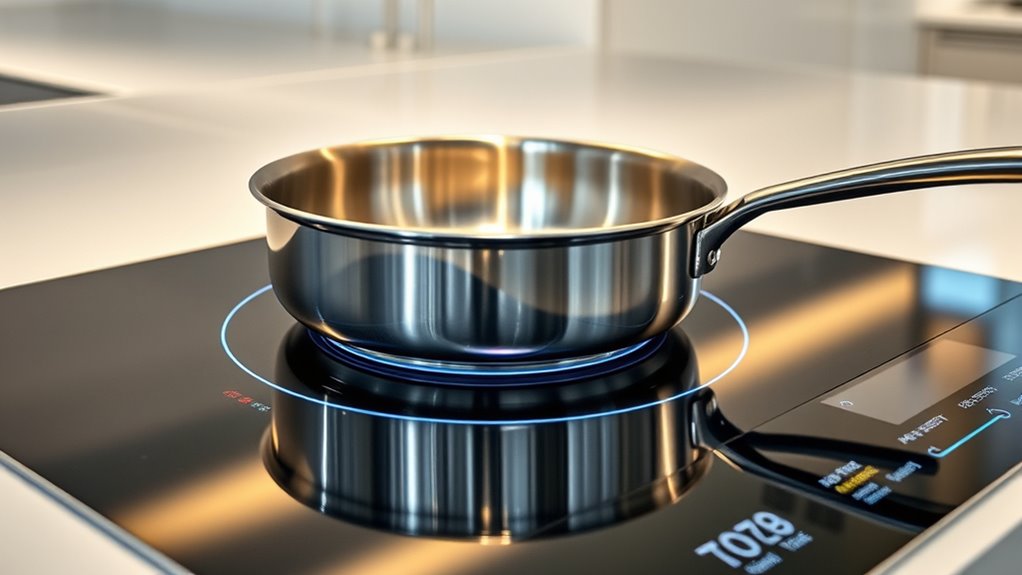
Are you wondering what makes some cookware suitable for induction cooktops while others aren’t? The key difference lies in their magnetic properties. Suitable cookware must have a ferromagnetic base that responds to the cooktop’s magnetic field. Unsuitable pans lack this feature and won’t heat properly.
Cookware compatible with induction cooktops must have a magnetic, ferromagnetic base to heat effectively.
Here are four critical differences:
- Material: Suitable pans are made of cast iron, magnetic stainless steel, or enameled steel. Unsuitable ones are usually aluminum, glass, or copper.
- Magnetic Response: Only cookware with magnetic properties will activate the induction element.
- Base Thickness: Thicker bases promote even heat transfer, improving efficiency.
- Flatness: Flat bottoms ensure full contact with the cooktop for maximum energy transfer.
Knowing these differences helps you select the right cookware for your induction stove.
Identifying Induction-Compatible Pans
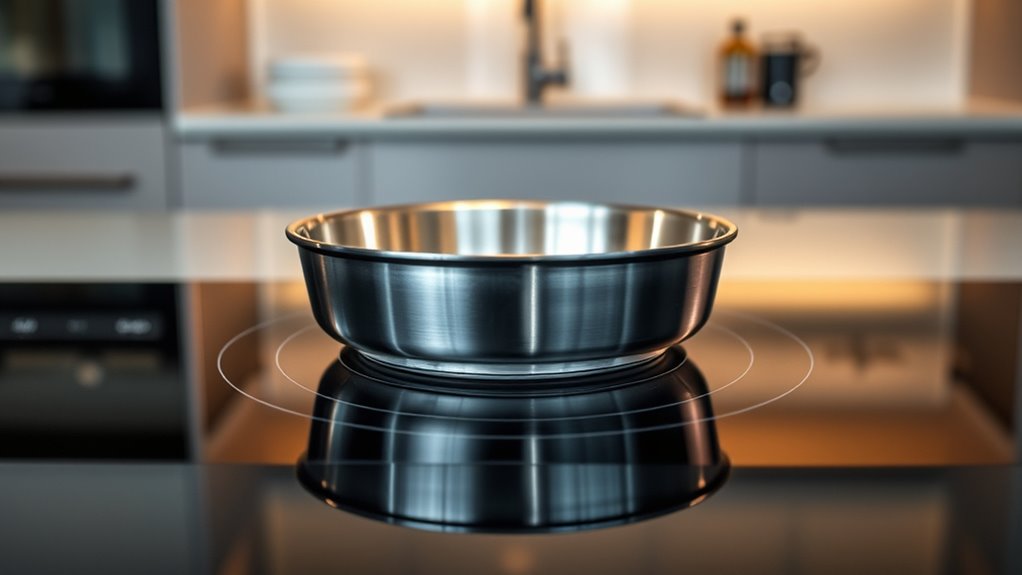
To identify induction-compatible pans, start by checking if the cookware responds to a magnet. If the magnet sticks firmly, chances are it’ll work on your induction cooktop. Look for labels or symbols indicating compatibility, but a magnet test is the most reliable method. Some pans, like cast iron and certain stainless steel, work well, while aluminum or copper alone won’t unless they have a magnetic base. Here’s a quick guide:
| Material | Magnet Test | Compatibility |
|---|---|---|
| Cast Iron | Yes | Compatible |
| Stainless Steel | Yes | Usually compatible |
| Aluminum | No | Not compatible |
| Copper | No | Not compatible |
| Multi-layer | Yes or no | Check base material |
Use this table to quickly identify which pans will work. For optimal performance, choosing induction-compatible cookware ensures efficient heat transfer and safety during cooking. Being aware of material properties can help prevent frustration and ensure your cookware functions properly. Additionally, understanding the magnetic response of different metals can assist in making informed choices for your kitchen. Recognizing the importance of proper cookware selection can also extend the lifespan of your cookware and improve your overall cooking experience. Moreover, selecting the right base material can influence heat distribution and durability over time.
The Impact of Using the Wrong Pans on Performance
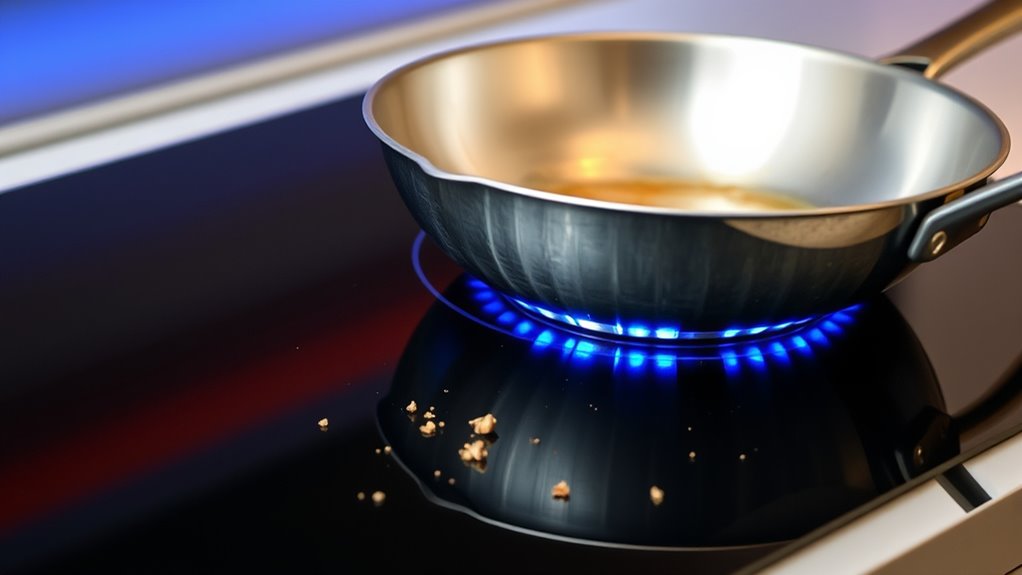
Using the wrong pans on your induction cooktop can considerably hinder its performance. Non-compatible cookware can lead to slower heating, uneven cooking, or even no heat at all. This not only wastes time but also energy, making your cooking less efficient. Here are four impacts to contemplate:
Using incompatible cookware reduces efficiency and can damage your induction cooktop.
- Reduced Heat Transfer – Poor contact prevents efficient energy transfer. Ensuring the cookware has a magnetic base is essential for optimal performance. Additionally, the material composition of the cookware plays a key role in heat conduction.
- Longer Cooking Times – You’ll spend more time waiting for food to cook.
- Uneven Heating – Hot spots can burn or undercook your dishes.
- Potential Damage – Non-compatible pans can damage the cooktop’s surface or sensors. Using appropriate cookware ensures better heat conduction and protects your appliance.
Using the right pans ensures ideal performance, saves energy, and helps you cook evenly. Avoiding incompatible cookware keeps your induction cooktop working smoothly.
Tips for Choosing the Right Cookware for Your Induction Stove

To get the best performance from your induction stove, you need cookware that’s compatible and efficient. Focus on materials that work well with induction, ensuring a flat bottom for even heating, and choose sizes that fit your burners perfectly. These tips help you select cookware that heats quickly and cooks evenly every time.
Material Compatibility Essentials
When choosing cookware for your induction stove, understanding material compatibility is essential. Not all metals work with induction, so selecting the right material guarantees efficient heating. Look for cookware made of magnetic materials, such as cast iron or certain stainless steels. To help you decide, here are key points:
- Use ferromagnetic metals—these are magnetic and work well with induction.
- Avoid non-magnetic materials like aluminum, copper, or glass unless they have a magnetic base.
- Check for induction-compatible symbols on the cookware packaging.
- Test your pan with a magnet—if it sticks, it’s suitable for induction.
Flat Bottom Advantage
A flat bottom is vital for peak performance on your induction stove because it guarantees maximum contact with the cooktop surface. When your pan’s base is smooth and even, heat transfer happens efficiently, reducing hot spots and uneven cooking. Avoid pans with warped or rounded bottoms, as they create gaps that hinder induction’s magnetic field from working properly. A flat bottom ensures consistent heating and better energy use, saving you time and electricity. It also helps the cookware sit securely on the surface, preventing slipping or wobbling during cooking. When selecting cookware, prioritize flat, smooth bases to maximize induction performance, improve heat distribution, and ensure safe, reliable cooking results.
Size and Shape Fit
Ensuring your cookware fits properly on your induction stove is key to achieving ideal performance. If the pan is too small or too large, heat transfer becomes inefficient, and cooking times increase. To get the best results, pay attention to shape and size.
Consider these tips:
- Match the pan diameter to the induction zone for optimal contact.
- Use flat-bottomed pans to ensure even heating.
- Avoid oversized or oddly shaped cookware that may wobble or prevent proper contact.
- Check for a flat surface, as curved or warped bottoms reduce efficiency.
Choosing cookware that aligns with your stove’s size and shape ensures quick, even heating, saving energy and improving your cooking experience.
Frequently Asked Questions
Can I Use Aluminum or Glass Pans on Induction Cooktops?
You can’t use aluminum or glass pans on induction cooktops unless they have a magnetic base. Induction works by creating a magnetic field that heats the pan directly. Aluminum and glass aren’t magnetic, so they won’t heat up unless they have a compatible magnetic layer. To guarantee proper heating, look for cookware labeled as induction-compatible, typically made with ferromagnetic materials like cast iron or certain stainless steels.
Do All Stainless Steel Pans Work With Induction Stoves?
You might think all stainless steel pans work with induction stoves, but surprise—only those with a magnetic base do. If your pan isn’t ferromagnetic, it won’t heat up, no matter how shiny or expensive it looks. So, don’t assume your stainless steel cookware is compatible; test it with a magnet first. If it sticks, you’re good to go. If not, it’s time for a new pan or an upgrade.
How Do I Test if My Pan Is Induction-Compatible?
To test if your pan works with induction, place a magnet on its base. If it sticks firmly, your pan is induction-compatible. If the magnet doesn’t stick or only weakly clings, it probably isn’t suitable. You can also check the pan’s label or manufacturer’s info. Keep in mind, not all stainless steel pans are compatible, so a quick magnet test helps you determine if your cookware will work efficiently on an induction cooktop.
Are There Health Concerns With Magnetic Cookware?
Imagine a gentle breeze guiding your choice. Magnetic cookware is generally safe because it’s made from common metals like cast iron or stainless steel, which are widely used in kitchenware. No significant health risks have been linked to their use. Just guarantee your pans are clean and in good condition. If you have specific health concerns or metal allergies, consult your doctor for personalized advice.
Can I Convert Existing Cookware to Induction-Compatible?
You can convert your existing cookware to induction-compatible if it has a magnetic base. Use a simple magnet—if it sticks firmly, your pan should work. Otherwise, you’ll need to buy new cookware designed for induction. Keep in mind, some non-magnetic materials like aluminum or glass won’t work unless they have a magnetic layer added. Testing with a magnet is the easiest way to determine compatibility.
Conclusion
Now that you know how induction cooking works and why only certain pans work, it’s no surprise that choosing the right cookware makes all the difference. When you pick the correct ferromagnetic pans, you’ll enjoy faster, more efficient cooking—and maybe even discover a new favorite in your kitchen. Coincidentally, that perfect pan might just be waiting in your cupboard, ready to transform your cooking experience with your induction stove.
